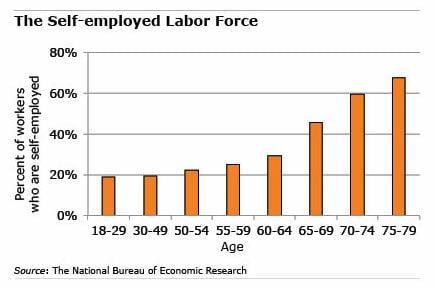
Self-Employment More Prevalent Over 65
Workers of all ages are being affected by the damage COVID-19 is doing to the economy, but people who are loosely attached to the labor force may be more vulnerable.
That’s the situation for a small but growing segment of the U.S. labor market: self-employed people who are 65 and older.
When workers are in their prime, most of them are directly on an employer’s payroll. But a new study finds that self-employment begins to dominate as people work past traditional retirement ages and work as independent contractors, consultants, freelancers, or gig workers.
 The detailed Gallup survey designed by the researchers shows that self-employment is more pervasive at older ages than previous data had indicated. Nearly half of all workers in their late 60s are self-employed, and that rises to more than two-thirds of workers in their late 70s. In contrast, only one-fourth of people in their late 50s are self-employed.
The detailed Gallup survey designed by the researchers shows that self-employment is more pervasive at older ages than previous data had indicated. Nearly half of all workers in their late 60s are self-employed, and that rises to more than two-thirds of workers in their late 70s. In contrast, only one-fourth of people in their late 50s are self-employed.
The Gallup survey was designed to capture self-employment more fully than the Bureau of Labor Statistics (BLS) does. That’s because the researchers asked detailed questions designed to get a more complete count of the independent contractors who may mistakenly have failed to report themselves as self-employed to the BLS.
In the study, independent contractor is the most common form of self-employment at older ages. This is mainly the province of an elite group who are able and willing to continue working several years after most people have retired. They are often professionals or former managers who said their primary motivations for being self-employed are remaining active or pursuing an interest.
But even at the oldest ages, a significant minority of independent contractors are working mainly for the money.
About one in four older people who are independent contractors work for a former employer. These relationships can either be by choice or the result of the employer cutting a worker’s job and then hiring him back on a contract basis to retain his expertise.
Self-employment functions well for older workers because they can “cut back on their hours … rather than withdraw entirely from the labor force,” the researchers said in their study for the Retirement and Disability Research Consortium.
But now that the pandemic is throwing people out of work, the question facing the nation’s oldest workers is: how will my situation change?
To read this study, authored by Katharine Abraham, Brad Hershbein, and Susan Houseman, see “Contract Work at Older Ages.”
The research reported herein was derived in whole or in part from research activities performed pursuant to a grant from the U.S. Social Security Administration (SSA) funded as part of the Retirement and Disability Research Consortium. The opinions and conclusions expressed are solely those of the authors and do not represent the opinions or policy of SSA, any agency of the federal government, or Boston College. Neither the United States Government nor any agency thereof, nor any of their employees, make any warranty, express or implied, or assumes any legal liability or responsibility for the accuracy, completeness, or usefulness of the contents of this report. Reference herein to any specific commercial product, process or service by trade name, trademark, manufacturer, or otherwise does not necessarily constitute or imply endorsement, recommendation or favoring by the United States Government or any agency thereof.
Comments are closed.







This study doesn’t answer the most important question – the one you highlight in your blog – are these folks self employed by choice, or because they got laid off from a former employer. The smart folks at the CRR should follow up this study with an analysis using HRS panel data.
One other question to ask is whether they are self-employed by choice or self-employed because they were unable to secure more traditional employment – due to actual or perceived differences in hiring older workers. You have other studies that suggest turnover of older workers – that the employer at age 62 is not the same employer as in place at age 50.
The bottom line is that America has long needed legislative and regulatory changes designed to change the focus of “phased retirement” initiatives from simply transitioning workers from full time, career employment into full time leisure. There should be just as much, if not more focus on adopting structures that facilitate and encourage employers to hire experienced workers who seek “flexible employment”. Some minor changes in code and regulations would help employers achieve a competitive advantage when hiring older workers – by adding cost-effective skilled workers while concurrently taking them away from competitors.
Wouldn’t it be a welcome change to see employers competing for talent regardless of age?
Too many people think that the needed changes are age discrimination – reducing the cost to hire an older worker, providing a safe harbor for employers comparable to the OWBPA safe harbor for early retirement windows, etc.
We can do better.